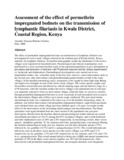| dc.contributor.author | Akumbi, Dunstan MN | |
| dc.date.accessioned | 2012-11-13T12:42:17Z | |
| dc.date.available | 2012-11-13T12:42:17Z | |
| dc.date.issued | 2000 | |
| dc.identifier.uri | http://erepository.uonbi.ac.ke:8080/handle/123456789/6209 | |
| dc.description | (data migrated from the old repository) | |
| dc.description.abstract | The effect of permethrin impregnated bed nets on transmission of lymphatic tilariasis was investigated in twelve study villages selected in the southern part of Kwale district. Kenya. endemic for lymphatic filariasis. In baseline demographic studies the inhabitants of the twelve villages were registered in household units. Parasitological and clinical examinations were performed in a cross-sectional baseline study in the registered population to give information on prevalence and intensities of infection with Wuchereria bancrotti and the clinical manifestation
i.e. hydrocele and elephantiasis. Entomological investigations were carried out in two longitudinal studies. one. a baseline study in the first year: and two. a post-intervention study in the second year. after intervention with permethrinimpregnated bednets in half of the study villages. In the baseline entomology study. mosquitoes were caught by three light traps during one night every fortnight in each of the twelve study villages. The vector species caught were dissected to record infection and infectivity with developing stages and the infective stage (L~) of W bancrotti. After the baseline studies the twelve villages were paired and one of each pair was randomly selected to form six intervention villages while the other six served as controls. Enough permethrin impregnated bed nets to cover everybody in each household were issued to the intervention villages and a follow up to ensure usage conducted. The post-intervention entomological study was conducted in the same way as in the baseline entomology study. In addition. just before intervention with permethrin impregnated bednets. night blood specimens were obtained from one whole village and from children aged 1-10 years. tor studies on the effect of the intervention on the circulating tilarial antigen and microfilaraemia. The blood specimens were again obtained from the same section of the population one year post-intervention. Results from the baseline clinical and parasitological studies indicate an overall microfilarial prevalence of 16.0 % among the 6531 examined villagers. and overall hydrocele and limb elephantiasis rates of 20% and 2.8% respectively. In entomology results. three vector species. Anopheles gambiae .'II. An. funestus and Culex quinquefasciatus were present. During the baseline entomological study year An. funestus was the most abundant species (77%) followed by An. gambiae (14.7%) and Cx. quinquefasciatus (8.3%). The overall infection and infectivity rates in the three vector species over the twelve villages was 4.9% and 2.1 % respectively tor An. gambiae. 2.3% and 1.0% respectively tor An. tunestus. and 3.1% and 1.2% in ex. quinquefasciatus. The overall annual infective biting rate (AIBR) and annual transmission potential (A TP) in the three vector species together was 267 and 526 respectively. After intervention with permethrin impregnated bed nets, the mosquito densities were marginally reduced by only 3.6% in the 3 vector species together and 33.7% in both anopheline vectors. In individual species reductions of 10.7% and 43% were achieved in An. gambiae and An. funestus respectively. while there was no evident reduction in a Cx. quinquefasciatus. There was a dramatic reduction in the AIBR and A TP with overall relative reductions of 92% and 95% respectively. This indicates that although permethrin impregnated bednets only marginally reduce the mosquito biting densities. they exert a very strong suppressive effect on the actual transmission of lymphatic filariasis. The effect of permethrin impregnated bednets on the circulating filarial antigen was not clearly defined after one year of intervention. This indicated that the detectable antigen is mainly of adult worms and not of any earlier stages. thus can only be detected at least after 8 months - the prepatent period for W. bancrotti. | en_US |
| dc.language.iso | en | en_US |
| dc.publisher | University of Nairobi | en_US |
| dc.subject | Filariasis | en_US |
| dc.subject | prevention and control - Filariasis | en_US |
| dc.subject | Kenya | en_US |
| dc.subject | Coast Province | en_US |
| dc.subject | Lymphatics | en_US |
| dc.subject | Infections | en_US |
| dc.title | Assessment of the effect of permethrin impregnated bednets on the transmission of Lymphantic Filariasis in Kwale District, Coastal Region Kenya | en_US |
| dc.title.alternative | Thesis (Ph.D) | en_US |
| dc.type | Thesis | en_US |

